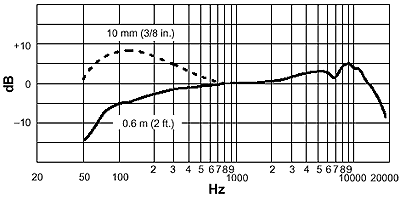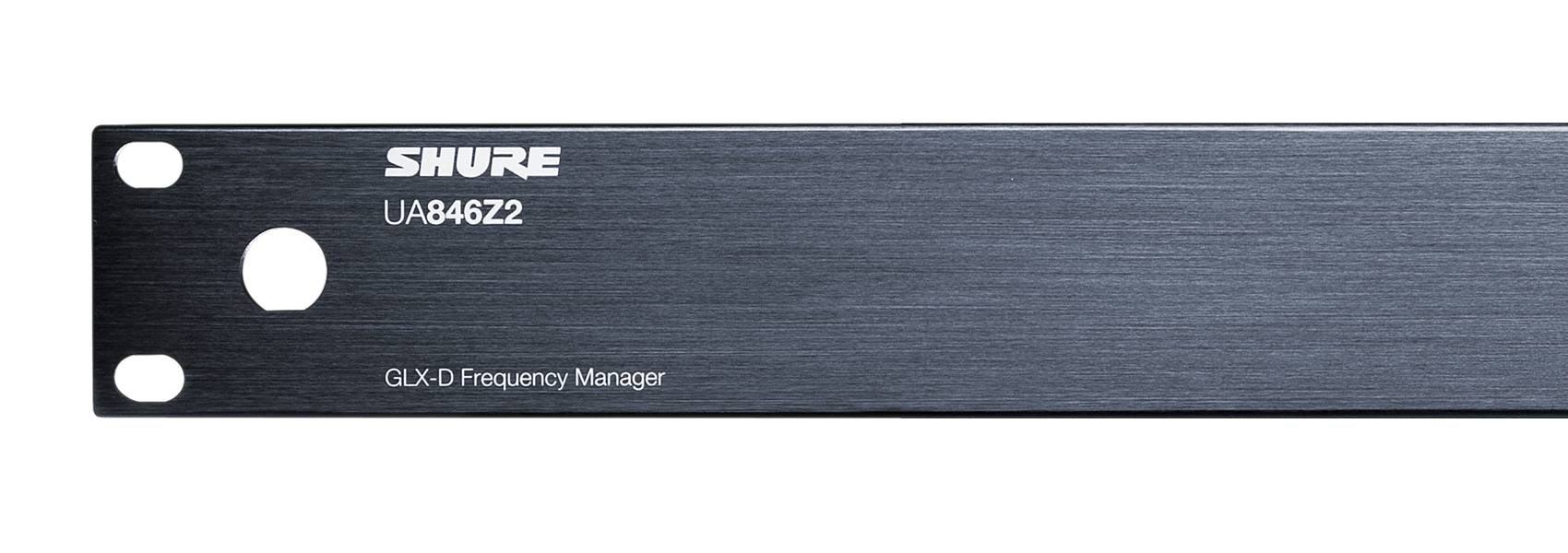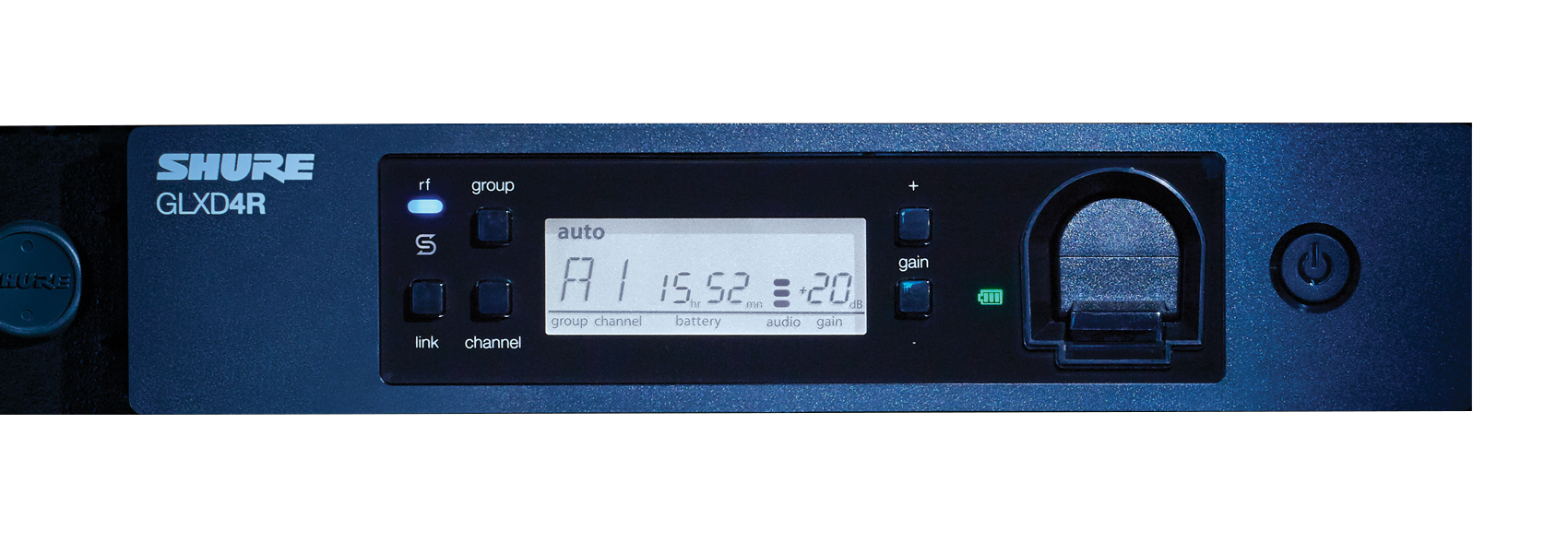Firmware updates are part of the maintenance of your electronic devices. The Shure Update Utility (SUU) is a free desktop application for Mac and Win…
How can you bring more energy to the stage? Set the performers free with digital wireless. GLX-D® Advanced Digital Wireless adds more capacity—and more ways to keep the show moving. Ideal for clubs, houses of worship, or other small to mid-sized venues, it’s the gear that breaks performance wide open.
Main Features
Main Features
- Available Transmitter Form factors: Bodypack, Handheld
- Operating range (up to): 20-30 m (Under typical conditions)
Exceptional Digital Audio Clarity
The clearest sound from world-renowned Shure microphones with proprietary Shure digital wireless technology.
Intelligent Rechargeability
Proprietary Lithium-ion rechargeable batteries with accurate battery metering for up to 16 hours of use when fully charged.
Rock-Solid RF Performance for Multiple System Installations
GLX-D Frequency Managers provide improved RF performance, antenna distribution and seamless frequency management for up to 9 GLX-D Advanced rack mount systems in typical environments (11 under optimal conditions).
Automatic Frequency Management
Linked GLX-D Advanced wireless receiver communities easily identify and continuously move away from interference, finding the clearest channels for all systems.
Rack-Mountable for Multi-System Efficiency
Included mounting hardware and detachable antennas make it easy to install multiple GLXD4R rack mount receiver systems.
Full Accessory Suite for Remote Antenna Management
Frequency managers, directional antennas, antenna splitters and remote mounting accessories are available to maximize system performance in various environments.
Description
GLX-D® Advanced Digital Wireless offers rechargeability and rock-solid RF performance while increasing channel count via a suite of flexible products that provide the best sounding, most user-friendly 2.4 GHz multi-system wireless experience.
Ideal for installations at small to medium houses of worship, schools and music venues.
Wireless Sets
Wireless Sets
Components
Components
Specs
Specs
Technical specifications



Further Technical Specifications
- Dynamic Range: 120 dB, A-weighted
- Audio Frequency Response: 20 Hz – 20 kHz
(Note: Dependent on microphone type) - Total Harmonic Distortion: 0.2%, typical
- Latency: Groups 1 and A: 4.0 ms; Groups 2, 3, 4 and B: 7.3 ms
- Cross-Subnet Connection/Control: No
- Operating Temperature Range: -18°C (0°F) to 57°C (135°F)
(Note: Battery characteristics may limit this range.) - Encryption: No
- No. of compatible systems: Up to 9 typical (requires Frequency Manager). Without Frequency manager up to 4 typical
- Transmission: Digital on 2.4 GHz
- High density mode: No
- Interference detection: No
- Remote control: No
- DANTE Audio Network Interface: No
- System Audio Polarity: Positive pressure on microphone diaphragm (or positive voltage applied to tip of WA302 phone plug) produces positive voltage on pin 2 (with respect to pin 3 of low-impedance output) and the tip of the high impedance 1/4-inch output.
Compatible Software
Compatible Software
Downloads
Downloads
Brochures
User Guides
Comparable products
Comparable products
Optional accessories
Optional accessories
faq
Are digital wireless systems all WiFi?
Digital wireless doesn't mean that it's WiFi. It refers only to the type of data being transmitted by radio.
As an example, Shure's QLX-D and ULX-D systems both use UHF spectrum in the 470-790 MHz band, whereas the GLX-D system uses 2.4 GHz (2,400 MHz) WiFi. Don't worry, though, you're not going to start picking up other peoples' facetime calls on your receiver; while coexisting with WiFi, intelligent 2.4GHz systems consider this traffic as interference and avoid it automatically.
Are rechargeable batteries worth the extra cost?
Yes. As well as being green and good for the environment, the lithium ion rechargeable cells will save you money and simplify your inventory – cutting out last-minute trips to purchase AA batteries just before your gig (yep, we've all been there. Why are batteries SOOO expensive?!).
Here's a cost comparison of one transmitter that uses fresh batteries once a day, and is used 4 times per week. Prices of AA batteries were from the website.
It's clear that although the upfront cost for the rechargeable cell is greater, the cost savings kick in around the 1 year mark.
Are there different transmitters?
No. There is only one series of transmitters. These can be used with GLX-D receivers (GLXD4 and GLXD6) as well as with GLX-D Advanced receivers (GLXD4R).
Can I send it over my existing digital audio network?
A digital radio microphone system refers specifically to the RF modulation scheme. In the receiver this is converted into an analogue audio signal for connection to an analogue desk or a guitar amplifier.
There are an increasing number of applications where keeping the audio in the digital domain has advantages. Shure have teamed with Audinate to use the Dante Digital Audio Network Protocol. Only our ULX-D dual and quad receiver systems have this capability. The audio from these receivers can be streamed via a network to other Dante receivers. (While confusing at first, the ULX-D wireless receiver becomes a Dante transmitter…). Remember that there are specific network requirements in order to do this; primarily a low-latency gigabit network with Quality of Service features engaged. Learn more at the following link: https://www.audinate.com/resources/networks-switches
Can I use standard GLX-D Systems with the new GLX-D Advanced systems?
If you are not using the Frequency Manager, then the GLXD4R receiver operates similar to a GLXD4 receiver. In that case, follow the guidelines and best-practices for GLX-D.
If you are using the Frequency Manager, we recommend only one GLX-D standard system.
Does WiFi interfere with digital wireless?
Interference is always a concern when multiple services are sharing spectrum. Just like in our motorway example earlier, if there's more than on car on a road then a collision is possible. Our GLX-D system uses the same spectrum as WiFi (2.4 GHz), and so there is a chance of interference. To counteract this we need specialist technology that continually scans the 2.4GHz landscape to hunt out and avoid interference, leaving you with perfectly clean, interference-free audio.
Does digital mean no interference?
For 2.4GHz based digital systems, please see above.
For UHF based digital wireless systems, you need to coordinate your system to avoid external sources or interference in the same way you would an analogue system. The factor that swings in your favour, though, is the spectral efficiency of the system; so in the instance of getting interference, you are more likely to be able to avoid it. It's because the 'footprint' of digital wireless is way smaller than analogue, giving it more space in which to operate.
Some, more advanced digital systems (such as Shure ULX-D) have frequency diversity built-in. This permits two bodypacks to be used on two channels as a pair, to mic up one presenter for example. The audio from both packs is assessed by the receiver, and at any one moment, the best quality audio is routed to the receiver's XLR and Dante outputs, so if pack one goes bad, then the good pack's audio remains on. Admittedly, as soon as there is a break in the event, you need to replace the bad frequency with a clean frequency for pack one, but as far as the audience is concerned, you had no interference.
Does digital wireless still require antenna distribution and if so, can I use my existing distro/antenna?
GLX-D has fixed antennas and so does not need Antenna Distribution. That said, please still pay attention to antenna placement;
- Try to ensure line of sight
- Minimise transmission distance
QLX-D and ULX-D both use UHF spectrum and providing that your distros cover the RF range that your kit operates on, you'll be fine.
How does the audio compare? Is it true that digital wireless doesn't sound as good as analogue?
Ah, the age-old analogue vs digital question that is always laced with subjectivity. For wireless mics though, it's more objective.
On the whole, digital radio microphones will have more low end, top end and arguably sound more clear than analogue. This is due to a couple of reasons. Analogue systems are bound by the constraints of FM modulation which extends to highs around 15,000 Hz. Audio above this frequency is considered hard to hear at best, but it is noticeably missed when not present. This is especially true on bodypacks used for electric guitar where there will be more high-frequency content. The frequency response of digital systems such as ULX-D and QLX-D is 20Hz-20kHz, which results in a very full sound.
The other thing is, digital systems are not subject to noise picked up while being transmitted. In a digital transmitter, the first process applied to the incoming audio is the Analogue to Digital conversion. Now that the audio is represented in 0's and 1's, the transmitter will use what is typically a proprietary form of digital modulation to send this data. As the data being transmitted is digital, the receiver can perfectly recover the digital ones and zeros, thus recreating a perfect reconstruction of the original analogue sound – as well as avoiding picking up noise. This process also allows the frequency response to be much wider than analogue as we are no longer bound by the limitations of FM modulation.
How many channels I can run with GLX-D Advanced?
In an environment with no other WiFi devices you can run up to 11 channels. Under typical conditions (one WiFi channel is active) you can run up to 9 channels. The more WiFi channels active in an environment, the lower the max. amount of channels. Please be sure to use frequency manager.
How many systems can you use together?
The amount of systems you can run at any given time depends on the system you're using and the spectrum it operates in. To give you an example, a Shure GLX-D system allows you to use up to 8 systems together, but this requires the 2.4 GHz spectrum to be super clean. In normal circumstances, I would recommend using up to 4 systems together. If you need to regularly use more at once, then I'd (carefully) recommend using BLX or taking the jump to QLX-D.
Higher-end UHF based systems (such as QLX-D and ULX-D) can use up to 67 channels per frequency band. ULX-D also offers a High Density mode where up to 500 channels can be made to work together.
I have two channels of GLX-D Advanced. Is the Frequency Manager necessary?
No. When running two channels we recommend using the UA221-RSMA antenna splitter to split the incoming antenna signal to the two receivers
Is it licence free because it's digital?
The 2.4 GHz band is a license free part of spectrum and is available globally. It's limitations are the number of wireless microphones it can host; about 8 maximum. It's also relatively susceptible to interference as there are many other devices that use this band (mainly phones, tablets and laptops using WiFi). For this reason, we must build in features to avoid being caught out by interference (Interference Detection and Avoidance) as described in point #4.
Wireless systems operating in the UHF bands (QLX-D and ULX-D) require licencing just like any analogue radio microphone would; either a channel 38 license or a site-specific license.
What are the main differences between GLX-D and GLX-D Advanced?
The GLX-D Advanced receiver is rack-mountable and features detachable antennas. This allows users to use directional antennas, helping to increase system stability in environments with other WiFi sources.
The GLX-D Advanced Frequency Manager creates a shared group of frequencies for all receivers to use and automatically assigns frequencies to each receiver. If interference occurs, the frequency manager assigns new frequencies without audible dropouts.
What is the difference between Group A and B?
Group A is optimized for low latency (4 ms), ideal for a channel count of 6 systems, maximum 9.
Group B has a higher stability and a higher latency (7,3 ms), ideal if you experience interference or need to run 9 to 11 systems.
What's the range on digital wireless? Is it less than analogue?
The digital UHF systems have a similar range as other analogue UHF wireless microphone systems. There's no difference in the carrier frequency; the only difference is it's carrying digital information rather than analogue.
Systems operating in the 2.4 GHz band use a higher frequency to transmit audio and so will have a lower, or smaller operating range. Physics is physics.
Why do I need digital wireless? My stuff works fine RIGHT now!
Two words; spectral efficiency. Demand for wireless microphones increases year on year, while at the same time, the amount of clear spectrum available is shrinking. More mics in less space means it's going to get crowded pretty quickly, and the amount of radio 'space' each channel takes up needs to be reduced to keep up with demand. Wireless spectrum, after all, is a finite resource; there is only so much to go around. If the demand for wireless products across the board continues to increase at the current pace, all users will need to be more spectrally efficient (including consumer goods).
It's a bit like lanes on a motorway. Previously we had, say 8 lanes, and only 3 big-ass trucks needed to run simultaneously; not much traffic and plenty of space. Now we have 4 lanes and we're trying to run 20 trucks side by side; there's not a lot of space. Using efficient digital systems, it'd be like running 20 super-narrow trucks in the same 4 lanes; a solution that will actually work.
Why would I need encryption?
Radio microphones are used at a large number of events where sensitive information is shared. Without encryption, it's possible to receive the signal from a radio microphone on a separate receiver tuned to the same frequency and with a similar modulation scheme (digital or analogue as appropriate).
As unlikely as it many may be that anyone would spy and try to steal sensitive information, it unfortunately does happen in the interests of gaining a competitive advantage.
Analogue radio microphones cannot be encrypted. Digital data can be encrypted using the AES-256 standard so that the transmitter sends the encrypted data rather than the unencrypted source data. Now, if a digital receiver is tuned to the same frequency, but doesn't know the encryption key, no audio will be recovered; your sensitive information remains safe.


